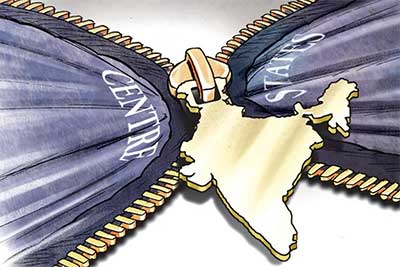Relevance: GS-3: Indian Economy and issues relating to Planning, Mobilization of Resources, Growth, Development and Employment.
Key Phrases: Fiscal deficit, GST compensation cess, Fiscal federalism
Why in news?
- There is a clear divergence in the fiscal trends of the Government of India (GoI) and state governments
Analysis:
What is the status of state finances?
- The double whammy (also termed as scissor effect) of the Covid-19 pandemic — a collapse in revenue and rise in health-related and other costs — is likely to have a significant impact on state government finances.
- Average value of gross fiscal deficit to GSDP for the states which presented their budget before the outbreak of the pandemic is 2.4%, while the average for the remaining states that made post-outbreak budget presentations is 4.6%
- Combined revenue deficit of the state governments rose from 0.1% of GDP in 2018-19 to 2% of GDP in 2020-21 because of the pandemic
Status of center’s finances
- Centre’s fiscal deficit stood at Rs 5.5 trillion in April-October 2021, down from the Rs 7.2 trillion pre-pandemic level (April-October 2019), with incremental revenues outpacing expenditure.
- Despite the likely revenue foregone from the excise and customs duty relief, we expect the Centre’s net revenue receipts to exceed the budget estimate by Rs 1.7 trillion led by a robust performance of direct taxes and GST,
- Central transfers to states fell by Rs 0.9 trillion, with the decline split almost equally between grants and tax devolution
Centre State Financial Relations as mentioned in Indian Constitution
- Indian Constitution has provisions relating to:
- the distribution of the taxes as well as non-tax revenues
- the power of borrowing
- grants-in-aid by the Union to the States
- Article 268 to 293 deals with the provisions of financial relations between Centre and States.
- The Parliament has exclusive power to levy taxes on subjects enumerated in the Union List.
- The state legislature has exclusive power to levy taxes on subjects enumerated in the State List.
- Both can levy taxes on the subjects enumerated in Concurrent List whereas residuary power of taxation lies with Parliament only.
Problems with Centre-State fiscal distribution
- Various cess and surcharges, in which States’ have no share, are becoming a disproportionate portion of overall divisible revenue. This is against the spirit of fiscal federalism and financial devolution process-increased from 9% to 15% from 2014 of gross tax revenue
- States have constraints in managing their finances as the RBI controls their deficit and cannot float a bond on a state’s behalf without the Centre’s approval – debt to GDP ratio rose to 25% as 22% in 2015
- With the advent of GST framework, revenue autonomy of states has shrunk considerably as states have lost decision making power on tax rates. Also, there is a greater unpredictability associated with transfers of IGST and grants
- Since 2020-21, a portion of the GST compensation is being financed through back-to-back loans from the Centre, which enters state accounts as a financing item
Way ahead
- Fiscal consolidation through strengthening tax buoyancy rather than compressing public expenditure should be the approach
- Make central transfers more effective: Well-defined calendars for transfer; compositional shift from tied to untied transfers and reducing the levy of cess & surcharges, which are outside the divisible pool
- States have to be given more sources for tax collection or discontent will keep rising due to cross subsidy which is not going to go away anytime soon
- Reliance on centrally sponsored schemes should be reduced while tax devolution and grant in aids should be primary source of transfer
- Panchayats and municipalities should be devolved powers as given in 11th and 12th schedule
Source: Indian Express









